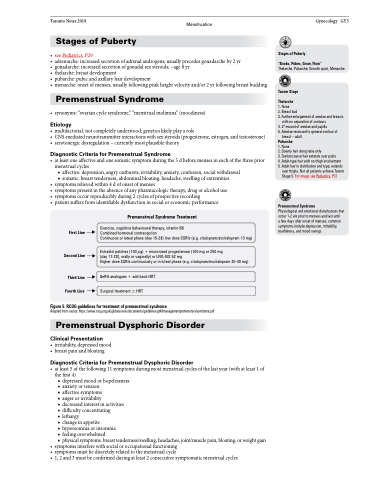Page 491 - TNFlipTest
P. 491
Toronto Notes 2019 Menstruation Stages of Puberty
• seePediatrics,P29
• adrenarche:increasedsecretionofadrenalandrogens;usuallyprecedesgonadarcheby2yr
• gonadarche:increasedsecretionofgonadalsexsteroids;~age8yr
• thelarche:breastdevelopment
• pubarche:pubicandaxillaryhairdevelopment
• menarche:onsetofmenses,usuallyfollowingpeakheightvelocityand/or2yrfollowingbreastbudding
Premenstrual Syndrome
• synonyms:“ovariancyclesyndrome,”“menstrualmolimina”(moodiness)
Etiology
• multifactorial:notcompletelyunderstood;geneticslikelyplayarole
• CNS-mediatedneurotransmitterinteractionswithsexsteroids(progesterone,estrogen,andtestosterone) • serotonergicdysregulation–currentlymostplausibletheory
Diagnostic Criteria for Premenstrual Syndrome
• atleastoneaffectiveandonesomaticsymptomduringthe5dbeforemensesineachofthethreeprior menstrual cycles
■ affective: depression, angry outbursts, irritability, anxiety, confusion, social withdrawal
■ somatic: breast tenderness, abdominal bloating, headache, swelling of extremities
• symptomsrelievedwithin4dofonsetofmenses
• symptomspresentintheabsenceofanypharmacologictherapy,drugoralcoholuse
• symptomsoccurreproduciblyduring2cyclesofprospectiverecording
• patientsuffersfromidentifiabledysfunctioninsocialoreconomicperformance
Gynecology GY5
Stages of Puberty
“Boobs, Pubes, Grow, Flow”
Thelarche, Pubarche, Growth spurt, Menarche
Tanner Stage
Thelarche
1. None
2. Breast bud
3. Further enlargement of areolae and breasts
with no separation of contours
4. 2o mound of areolae and papilla
5. Areolae recessed to general contour of
breast – adult
Pubarche
1. None
2. Downy hair along labia only
3. Darker/coarse hair extends over pubis
4. Adult-type hair with no thigh involvement 5. Adult hair in distribution and type; extends
over thighs. Not all patients achieve Tanner Stage 5. For image see Pediatrics, P31
Premenstrual Syndrome
Physiological and emotional disturbances that occur 1-2 wk prior to menses and last until
a few days after onset of menses; common symptoms include depression, irritability, tearfulness, and mood swings
First Line
Second Line
Third Line Fourth Line
Premenstrual Syndrome Treatment
Exercise, cognitive behavioural therapy, vitamin B6
Combined hormonal contraception
Continuous or luteal phase (day 15-28) low dose SSRIs (e.g. citalopram/escitalopram 10 mg)
Estradiol patches (100 μg) + micronised progesterone (100 mg or 200 mg
[day 17-28], orally or vaginally) or LNG-IUS 52 mg
Higher dose SSRIs continuously or in luteal phase (e.g. citalopram/escitalopram 20-40 mg)
GnRH analogues + add-back HRT
Surgical treatment ± HRT
Figure 5. RCOG guidelines for treatment of premenstrual syndrome
Adapted from source: https://www.rcog.org.uk/globalassets/documents/guidelines/gt48managementpremensturalsyndrome.pdf
Premenstrual Dysphoric Disorder
Clinical Presentation
• irritability,depressedmood • breastpainandbloating
Diagnostic Criteria for Premenstrual Dysphoric Disorder
• atleast5ofthefollowing11symptomsduringmostmenstrualcyclesofthelastyear(withatleast1of the first 4)
■ depressed mood or hopelessness ■ anxiety or tension
■ affective symptoms
■ anger or irritability
■ decreased interest in activities ■ difficulty concentrating
■ lethargy
■ change in appetite
■ hypersomnia or insomnia
■ feeling overwhelmed
■ physicalsymptoms:breasttenderness/swelling,headaches,joint/musclepain,bloating,orweightgain
• symptomsinterferewithsocialoroccupationalfunctioning
• symptomsmustbediscretelyrelatedtothemenstrualcycle
• 1,2and3mustbeconfirmedduringatleast2consecutivesymptomaticmenstrualcycles


